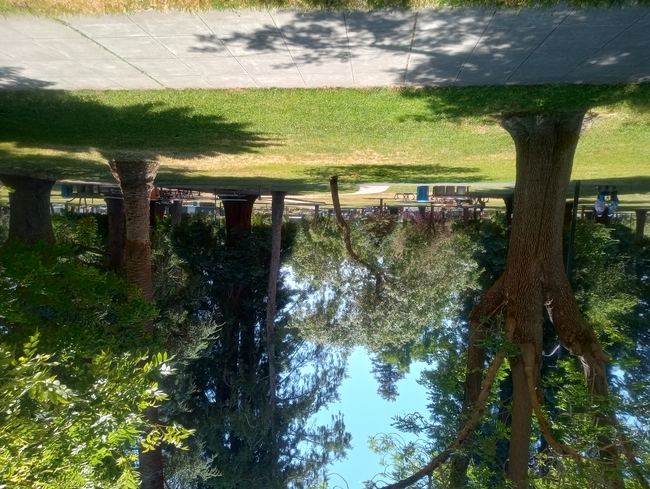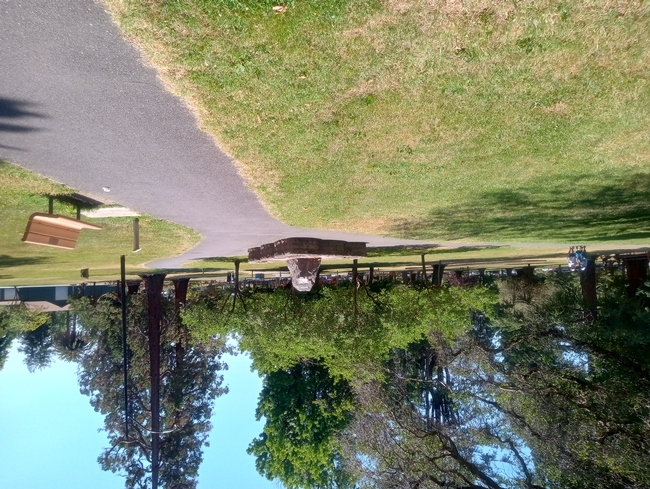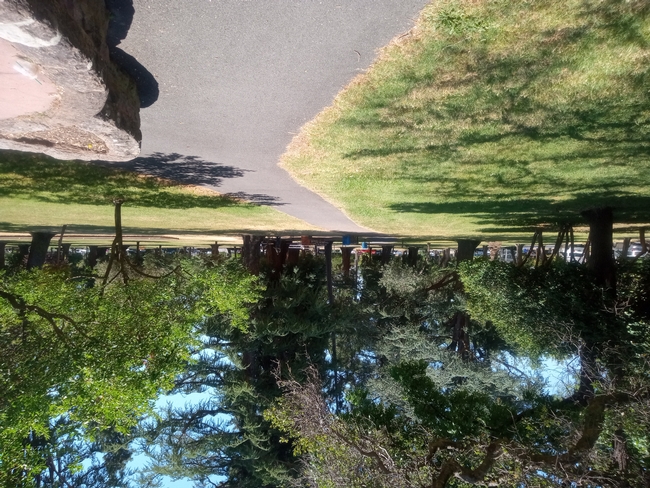It is well known that the Napa has many vineyards. Wine is what made this area famous. But did you know that there is another remarkable collection of plants from all around the world right in downtown Napa? Fuller Park is home to dozens of varieties of trees, both native and extremely exotic. Some varieties are famous. For example, the distinctive Atlas cedar (Cedrus atlantica) has appeared in literature, as well as the George Harrison song “Beware of Darkness.” There are many other trees with colorful histories in Fuller Park.
One, the dawn redwood (Metasequoia glyptostroboides), is a prehistoric tree. It existed during the Cretaceous period, the time of the dinosaurs, and was thought to be extinct. However, a forester in China discovered what he thought was a new tree. A Chinese scientist, Dr. Hu Hsen-Hu, sent specimens to his mentor at Harvard, and he distributed the seeds all over the world. The Fuller Park dawn redwood tree's source is probably from a trip to China made in 1948 by a University of California paleontologist, Dr. Ralph Cheney, and a San Francisco Chronicle science writer, Dr. Milton Silverman. They returned with seeds to distribute, and the Fuller Park dawn redwood was born.
The Bunya bunya tree (Araucaria bidwillii) is near Seminary Street. You can recognize it by the little fence surrounding it, as well as its size, razor sharp leaves, and enormous cones. The fence is in response to the fear of a 15-pound seed cone falling on someone's head (which has never happened, by the way). The Bunya bunya is native to the southern hemisphere. The seeds inside the cones are much bigger than almonds and are a valued source of food for the New Zealand native people.
Fuller Park, named after Mayor C.H. Fuller, who was mayor at the time of its purchase in 1905, has evolved from farmland to sports fields to a family-oriented park with beautiful plantings. It is a wonderful place to picnic, meet with friends, or simply relax by the rose garden. Children climb on playground equipment or practice soccer. Neighbors walk their dogs around the perimeter, and the excited chatter of squirrels looking for acorns can be heard from every corner. However, unlike most parks, when Fuller Park was planted the idea was to create an arboretum of unusual and native tree specimens for the public to enjoy. This vision has become a reality over the years.
Little did the founders of Fuller Park realize that, over a century later, it would have so much more value than merely being aesthetically pleasing. This community forest, and others like it, benefits our planet and the people in so many ways. As the earth gets hotter due to changing climate, trees play a vital role in reducing the impacts of this change through the absorption of carbon, a major contributor to global warming. The more mature a tree, the more carbon it can store. For instance, a mature can absorb more than 48 pounds of carbon dioxide annually. This is the equivalent of driving 50 miles. Carbon remains in the tissues of a tree until it is burned or decomposes. Trees also filter out fine particulate matter and ozone from the air, reducing air pollution. In addition, they can soak up pollutants in soil, such as cadmium, chromium, and lead, so they purify the soil as well.
Mature trees create ecosystems in urban areas. They provide habitat and food for birds, mammals, and other plants. This, in turn, sustains biodiversity.
In cities, vast amounts of concrete and asphalt raise the temperature considerably. This is called the “heat island effect.” Shade provided by trees cools heat islands. Trees also use evapotranspiration, a process in which they absorb water through their roots and cool the surroundings by releasing water vapor through their leaves.
As our climate warms, storms become more frequent and severe. Rain hits the ground at higher speed when there is a lack of tree cover. A canopy of leaves and branches slows down the rain, allowing it to enter the soil, leading to more water storage in the soil and less run-off, thus mitigating flooding.
There is a social benefit to having trees in urban areas. They create public spaces where people can gather, increasing a sense of community. Spending time in green areas around trees can increase a sense of well-being. Trees are a natural barrier to noise pollution, leading to stress reduction and a calming effect.
City trees have an economic benefit, too. They can reduce energy costs by providing shade, thus reducing the need for air conditioning. Trees and green spaces can increase property values for homes and businesses. Planting and maintaining healthy trees create job opportunities.
If you would like to learn more about the park and its trees, the U.C. Master Gardeners of Napa County offer informative walking tours that explain the characteristics of these beautiful trees as well as the history of the park. Tree Walks are done at an easy pace and last 1.5 to 2 hours. There is no charge. They start at alternate Fridays and Sundays from April through October. The remaining dates this year are June 14, July 21, August 16, September 15, and October 18.
For more information, visit our website: http://ucanr..edu/sites/ucmgnapa.
Workshop: Join UC Master Gardeners of Napa County for a workshop on “Welcoming Pollinators into Your Garden” on Sunday, June 16, from 2 pm to 4 pm, at Yountville Community Center, 6516 Washington Street, Yountville. Learn about host plants and nectar plants and how to include them in your garden. This workshop is offered in partnership with Yountville Parks and Recreation Department. Register on their website. Click Adult Activities, then UC Master Gardeners, then Planting for Monarchs and Other Pollinators.
Workshop: Join UC Master Gardeners of Napa County for a workshop on “Get Your Hands Dirty in the Pollinator Garden” on Saturday, June 29, from 10 am to 12 pm, at Las Flores Community Center, 4300 Linda Vista Ave, Napa. Help Desk: The Master Gardener Help Desk is available to answer your garden questions on Mondays and Fridays from 10 am until 1 pm at the University of California Cooperative Extension Office, 1710 Soscol Avenue, Suite 4, Napa. Or send your questions to mastergardeners@countyofnapa.org. Include your name, address, phone number and a brief description.
Become a Master Gardener Volunteer! UC Master Gardeners of Napa County is now accepting applications for the class of 2025. Visit us at napamg.ucanr.edu to read the informational brochure and register to attend a mandatory information session for applicants. Applications are due September 25, 2024 at 5:00 pm.


